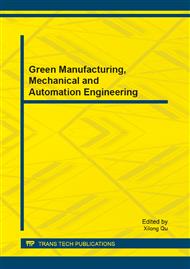[1]
Turan Paksoy, Nimet Yapici Pehliv. 2012. A Fuzzy Linear Programming Model for the Optimization of Multi-stage Supply Chain Networks with Triangular and Trapezoidal Membership Functions. Journal of the Franklin Institute 349(1), 93–109.
DOI: 10.1016/j.jfranklin.2011.10.006
Google Scholar
[2]
Hany Osman, Kudret Demirli. 2010. A Bilinear Goal Programming Model and a Modified Benders Decomposition Algorithm for Supply Chain Reconfiguration and Supplier Selection. Int. J. Production Economics 124 (1), 97–105.
DOI: 10.1016/j.ijpe.2009.10.012
Google Scholar
[3]
Nicola Costantino, Mariagrazia Dotoli, Marco Falagario, et al. 2012. A Model for Supply Management of Agile Manufacturing Supply Chains. Int. J. Production Economics 135 (1), 451–457.
DOI: 10.1016/j.ijpe.2011.08.021
Google Scholar
[4]
S.M.J. Mirzapour Al-e-hashem, H.Malekly, M.B. Aryanezhad. 2011. A Multi-objective Robust Optimization Model for Multi-product Multi-site Aggregate Production Planning in a Supply Chain under Uncertainty. Int. J. Production Economics 134 (1), 28–42.
DOI: 10.1016/j.ijpe.2011.01.027
Google Scholar
[5]
Leopoldo EduardoCa rdenas-Barron, Jinn-TsairTeng, GerardoTrevin o-Garza. 2012. An Improved Algorithm and Solution on an Integrated Production-inventory Model in a Three-layer Supply Chain. Int. J. Production Economics 136 (2), 384–388.
DOI: 10.1016/j.ijpe.2011.12.013
Google Scholar
[6]
SHU Liangyou, Yang Lingxiao.2009. Order Fulfillment Optimization Model of Manufactures Based on Time Competition. In: International Conference of Management Science and Information System part 3,393-396.
Google Scholar
[7]
YANG Lingxiao, SHU Liangyou.2011. Application of Particle swarm optimization in the Decision-Making of Manufacturers Production and Delivery, In: Electrical, Information Engineering and Mechatronics Vol.1, 83-89.
DOI: 10.1007/978-1-4471-2467-2_10
Google Scholar
[8]
S. Dhanalakshmi, S. Kannan, K. Mahadevan, S. Baskar. 2011. Application of modified NSGA-II algorithm to Combined Economic and Emission Dispatch problem. Electrical Power and Energy Systems 33 (4), 992–1002.
DOI: 10.1016/j.ijepes.2011.01.014
Google Scholar
[9]
K. Deb, S. Agrawal, A. Pratap, and T. Meyarivan. A fast and elitist multi-objective genetic algorithm: NSGA-II. IEEE Transactions on Evolutionary Computation, 6(2):182–197, 2002.
DOI: 10.1109/4235.996017
Google Scholar
[10]
K. Deb and R. B. Agrawal. 1995. Simulated binary crossover for continuous search space. Complex Systems 9(2), 115–148.
Google Scholar
[11]
K. Deb and M. Goyal. 1996. A combined genetic adaptive search (GeneAS) for engineering design. Computer Science and Informatics 26(4), 30–45.
Google Scholar


